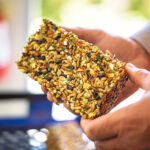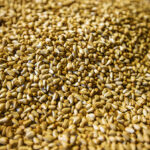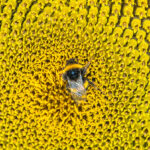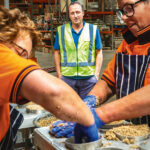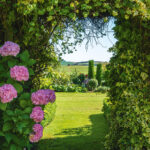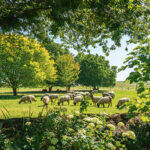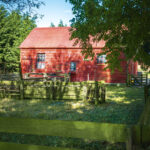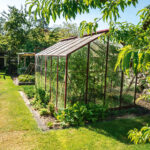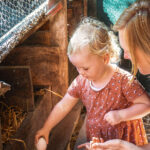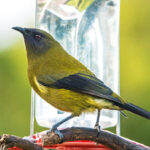50 years of flower farming: Two families harness the power of sunflowers for bird-food company Topflite
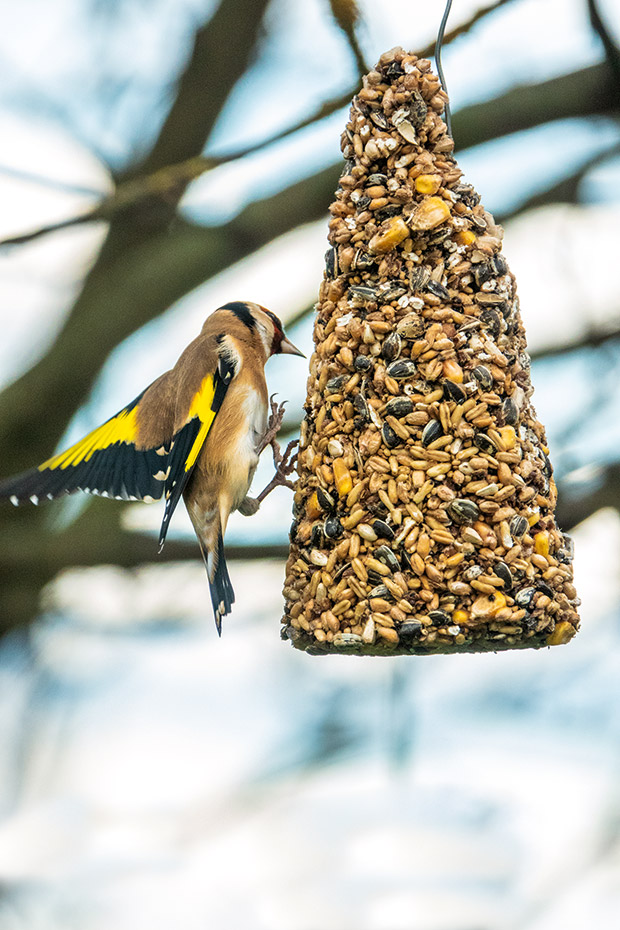
Two Waitaki families farming in partnership for more than 50 years have developed a bird-loving business out of a crop sown on a wing and a prayer.
Words: Emma Rawson Photos: Brian High
Riotous rows of yellow sunflowers beaming from fields south of Ōamaru are a shot of happiness in the Waitaki landscape. Sandwiched between crops of golden wheat and barley, the big friendly giants turn up the colour dial to a saturated yellow.
The exact location of the flowers, grown by the Mitchell and Webster families for more than 50 years, is usually kept on the low down.
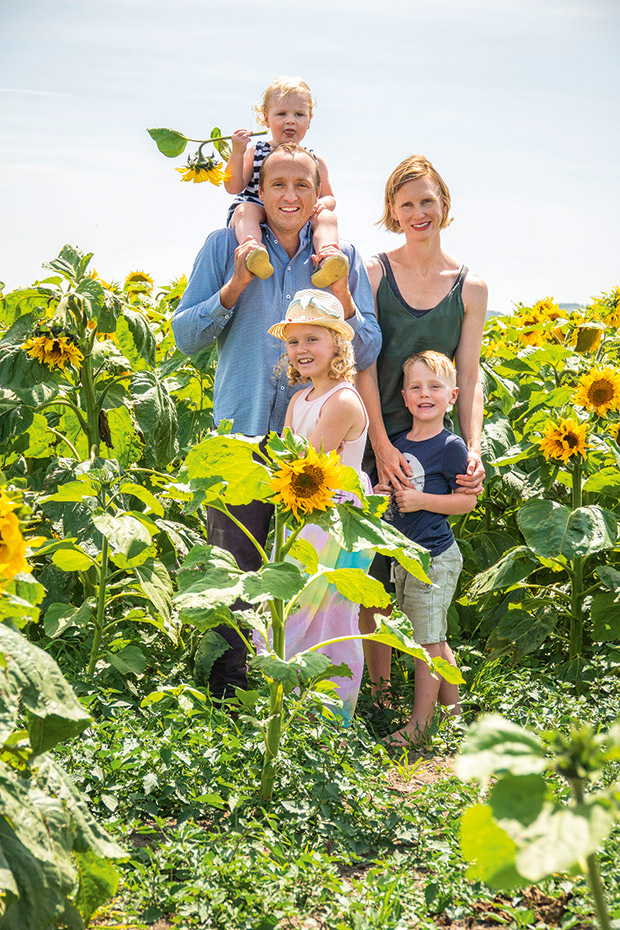
Greg Webster grew up helping his father Jock harvest sunflowers in their fields near Ōamaru. He now runs the business side of the family birdseed company, Topflite, and is no longer involved in the harvesting. His children Sylvie (2), Jack (5), Molly (8) and wife Carolyn have also been spared crop-gathering duties, but they are still big fans of the sunny blooms, which bring joy to humans and birds alike.
Sometimes they are planted on Thousand Acre Road between Ōamaru and Kakanui, sometimes further inland towards Enfield. Crop rotation is the official reason; sunflowers need a five-year interval before being replanted in the same field since they are prone to fungal disease. However, transplanting the lots has the bonus of tricking the birds and keeping humans on their toes until the flowers hit their full two-metre height and yellowy glory at the end of January.
Jock Webster won’t elaborate on the sorts of funny things some people attempt in the sunflower fields. The passers-by who take selfies (sometimes minus their clothes) in the flowers can get in the way of the birds as they swoop in for free tucker. Two hectares of sunflowers planted on a whim in 1974 by Jock and his brother-in-law Ross Mitchell have now grown into the bird- and pet-food company, Topflite. The two men have since passed down the business to their sons Greg Webster and Peter Mitchell.
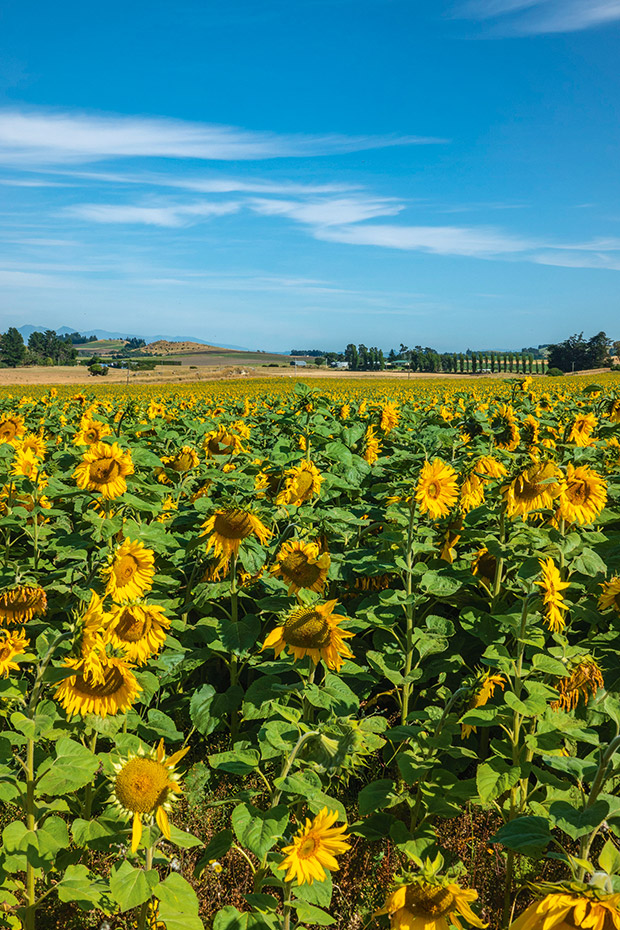
Not a bad place to work — a 30-hectare field of sunflowers grown by Peter Mitchell at Tōtara in Waitaki has views of the Kakanui Range in the distance and Tōtara Estate Hill (in the foreground).
Ross and his wife Ainslie started the partnership with Jock (Ainslie’s brother) and his wife Helen 50 years ago on their farms in Weston and Tōtara in Waitaki.
“Farming in a partnership is like being in another marriage,” says Helen. “You have your own marriage going on and then your business arrangement with another family who you end up seeing all the time.”
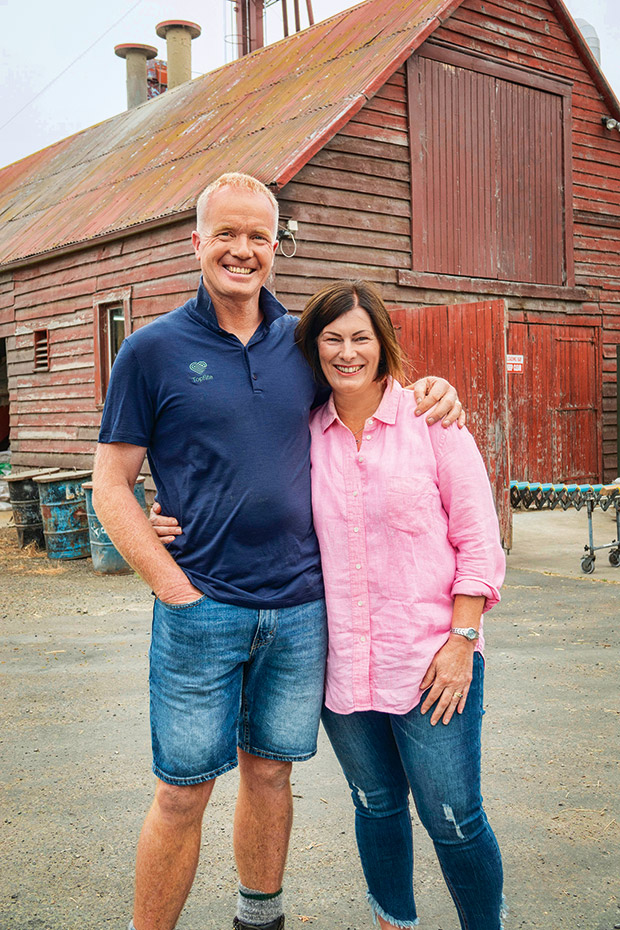
Peter and Sandra have been married for 28 years and have two adult sons, William and Henry. Sandra manages the accounts for the couple’s farm, Rosedale; safflower seed is used in bird bells and parrot seed mixes.
Adds Ross: “It hasn’t always been easy, but this arrangement has allowed us to be a bit experimental on the farm and try some interesting things.”
The two families initially grew sunflowers for the margarine industry; the flowers were such a novel crop in New Zealand that there was no machinery available locally for the purpose. A bit of Webster ingenuity and Ross’ “Mitchell modifications” saved the day.
A silverbeet-seed sower, which distributed seeds in 17-centimetre rows, was the closest thing to a sunflower sower. Jock had to stuff a piece of newspaper in every second hole of the drill to give the sunflowers the wide spacing they needed.
- Topflite’s Poultry Pecker is a seed block for good chooks who deserve a treat after a hard day’s laying, says Greg.
- Safflower seed is used in bird bells and parrot seed mixes.
- Bumblebees and honeybees both pollinate sunflowers.
- Topflite staffers Dawn Dunjey and Trish Murphy assemble seed bells at the company’s warehouse in Ōamaru. They have worked at the company for 14 and nine years respectively.
Jock reckons the neighbours must have thought they were a bunch of hippies. At the time, other farmers were finding golden opportunities in barley crops. The Mitchell/Webster flower farm was a little odd.
“The price of barley was getting better and better, and here we were trying to grow sunflowers. We had some big challenges at the beginning battling a fungal disease. People probably thought we were a bit funny in the head, especially when we planted more.”
The families discovered there wasn’t a enough of a margin on margarine oil. However, several bird breeders asked to buy the sunflowers for birdseed. A woman who worked with pet birds bought their entire harvest — 27 50-kilogramme bags. She sold the seed to owners of aviary birds, such as parrots and cockatiels. New Zealand-grown sunflowers were in short supply, and imported seeds are heat-treated and less nutritious to birds. Jock, who looked after the sales side of the business, saw a market niche.
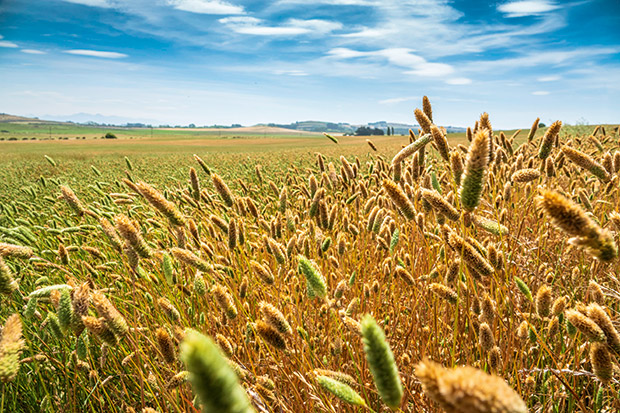
Canary grass seed, which Peter grows for Topflite, is enjoyed by many birds, including canaries.
Farmers often regard wild birds as freeloaders that steal crops. But, in Topflite, Jock and Ross have a business that’s as close as possible to making the birds pay for food —or, at least, their owners. They expanded their range to include other pet birdfeed, including canary, oilseed, rape and linseed. These were mixed with sunflower seeds in a granary at the Mitchell farm, Rosedale.
“Just about every piece of equipment was welded or modified to be more efficient in some way; it’s just what you had to do,” he says.
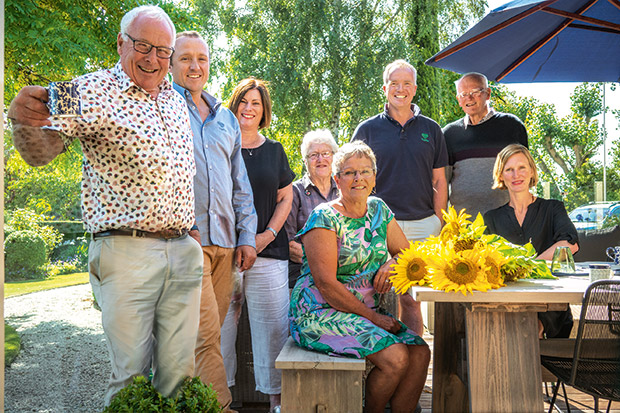
The Webster and Mitchell families (left to right): Jock Webster, Greg Webster, Sandra Mitchell, Ainslie Mitchell, Helen Webster (front), Peter Mitchell, Ross Mitchell, Carolyn Webster (front).
Eventually, a unique sunflower header front attachment was purchased from a tobacco-chewing farmer in Minnesota. The company expanded from wholesale-only to direct sales, and the Topflite brand was launched in 1996. In the years before the North Otago irrigation scheme came into action, farming in Waitaki was challenging.
“There was a drought about every three years, but that climate meant we were always open to new ideas,” says Ross.
- Jock and Helen have lived in their home, Tōtara, since they were married in 1978.
- The original part of the house is 140 years old, and some of the internal walls are made in Ōamaru stone with plasterboard over the top.
“We had some tough times. In the 1980s, the barley price crashed, and the sunflowers turned out to be a real godsend. It was an alternative market for us,” says Jock. “We’ve always told our kids to never, never, never give up. Sometimes you have to hang in there.”
The partners took a scientific approach to farming, utilizing Jock’s degree in agricultural science and Ross’ knack for engineering. Crop rotation, monitoring and diversification were vital, and seed selection helped ensure a robust genetic plant line. Peter, who manages the farm today, keeps this up with modern technology such as GPS, variable rate irrigation and grid testing for soil fertility to monitor crops and minimize the need for fertilizers and water use. In 2013, the farms won the supreme award in the Otago Ballance Farm Environment Awards.
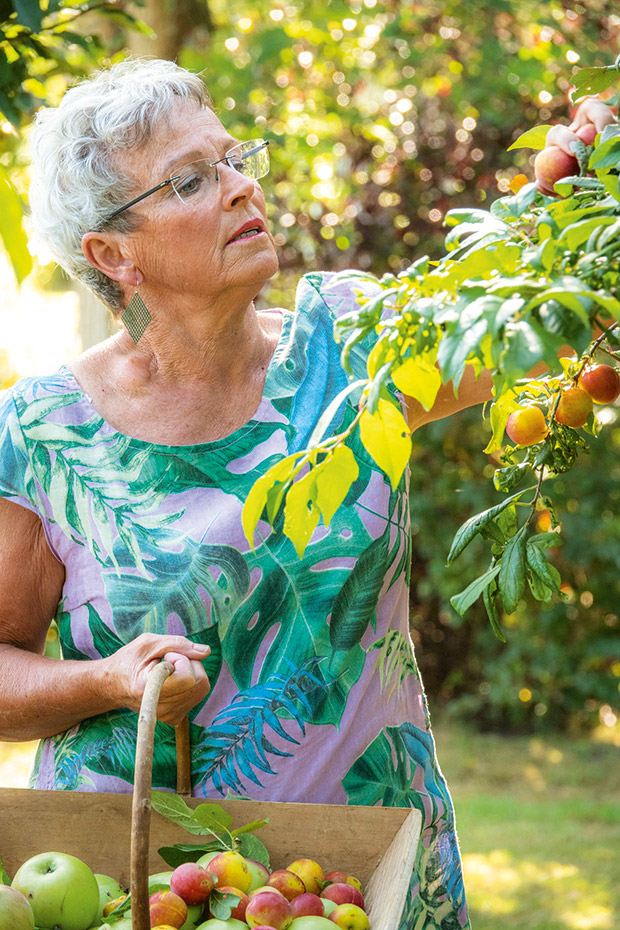
Helen and Jock’s garden has apple, apricot, nectarine, plum and quince trees and the greenhouse extends the growing season for tomatoes and salad greens;
“Jock and Ross were quite ahead of their time. These days, there’s a greater push to look after the environment. We’re always looking for sustainable ways to grow that are also economical,” says Peter.
As kids, Greg, Peter and their siblings got up to all sorts of mischief at the Mitchells’ Rosedale farm. They climbed the rails of the granary and jumped into enormous mountains of seed. Lincoln University student workers were often victims of water-balloon fights with Peter leading an assault perched on the top of a shed. Ainslie’s scones with apple jelly were a welcome peace offering.
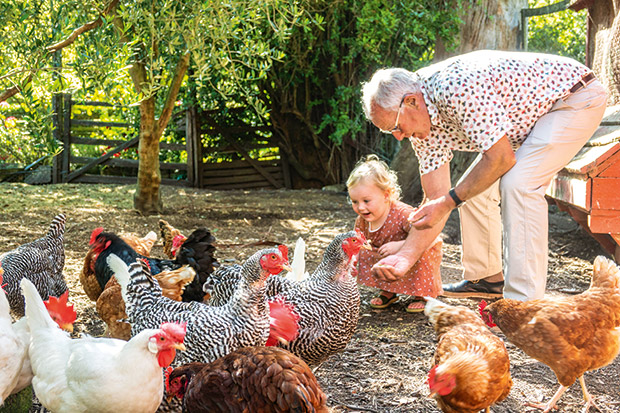
Although Helen and Jock have retired from most of their farming interests, they still keep 20 sheep and 15 chickens. Greg and Carolyn’s youngest child Sylvie is an animal-lover and likes to get hands on with Helen’s chooks.
The Webster and Mitchell kids picked up odd jobs; little hands were great at cleaning underneath the large seed-drying bins. They were, jokes Greg, like a New Zealand version of a chimney sweep. “There were lots of little jobs like that. My pay was usually a 50-cent lolly mix.”
His own children – Molly, Jack and Sylvie – have been spared such tasks. The Topflite warehouse and headquarters, in the industrial centre in Ōamaru, now employs 25 staff, with high-vis vests and hard hats aplenty. Greg took the job as general manager after Jock stepped back in 2015. Peter, who manages the farm on which much of the product is grown, lives in the old Rosedale homestead with his wife, Sandra, now that Ross and Ainslie have both retired.
Topflite products are available in pet stores, farm supply stores, garden centres, and small amounts are exported to Australia and Singapore. The range includes bird food for aviary birds as well as poultry and wild-bird seed and nectar. During a summer university holiday, Greg created the birdseed bells, which are now one of Topflite’s most popular products.
The company also makes some unusual petfood; mice feed and timothy hay for guinea pigs and rabbits. Helen used her pets to perfect some of the recipes. “Baby guinea pigs are so cute, and our grandkids adore them. We have an old cane doll’s pram that’s had more guinea pigs in it than dolls.”
The tiny 1.5-kilogramme bags of hay might raise eyebrows with other farmers who can’t fathom the idea of 1) a pet rabbit or 2) paying good money for a small packet of gourmet timothy grass hay to feed one.
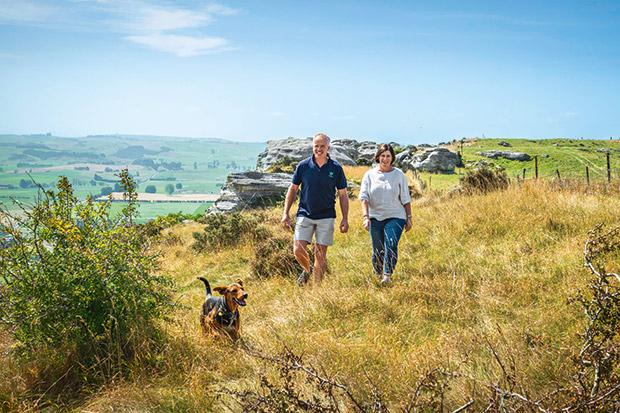
Rosedale Escarpment above Enfield is a great place to walk the dog, say Peter, Sandra and farm-dog Jip.
“Most farmers don’t think enough about the wonderful fact of added value,” says Jock. “When you’re raising sheep or cattle, you are subject to a lot of market forces that are outside of your control. But with an added-value product, we have more certainty and control over the returns.”
The idea of a pet mouse is even more challenging for a farmer. “A man wrote to us and said, ‘You’re not putting enough poison in that mouse mix; I have more mice than ever.’ So I sent him a mousetrap in the post, and he quite enjoyed the joke,” says Jock.
- More than 120 roses are planted at Rosedale farm.
- Sandra has maintained those originally planted by Ainslie and added more.
- Word in the bird world is that Rosedale Farm has good eats — the farm hosts tūīs, bellbirds/korimako, green finch, gold finch, chaffinch, sparrow, thrush, tauhou/blackbird, pīwakawaka/fantail, dunnock, red poll and grey warbler.
Topflite produces 2000 tonnes of animal feed a year, including 150 tonnes of budgie mix. Since New Zealand’s level four lockdown in April, it has seen an increase in sales of poultry feed and wild-bird seed while people enjoy more time at home.
“When I was growing up, a bird was a bird. We used to have tūīs flying around, but we didn’t pay much attention to them. But now there’s a growing awareness,” says Peter.
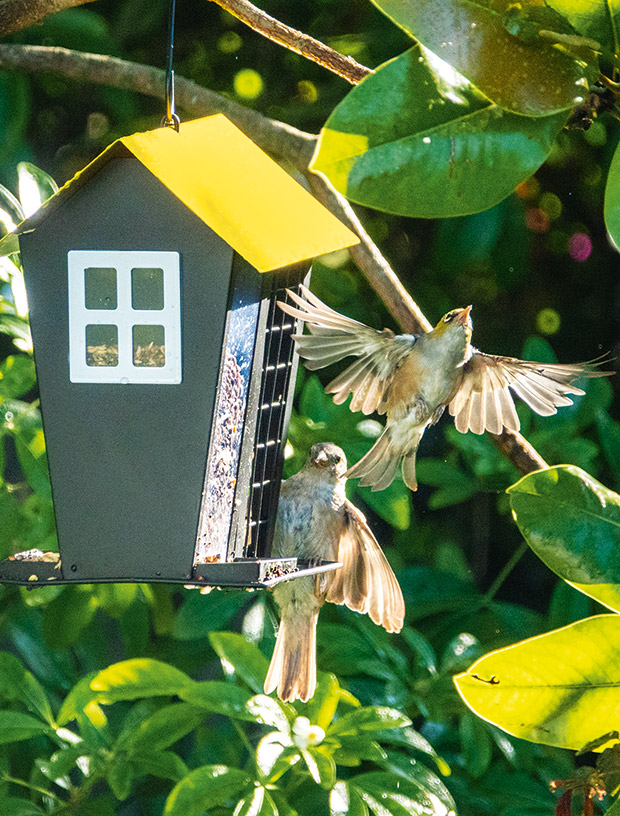
Adds Greg, “People are enthusiastic about helping wild birds. There is something lovely about seeing a waxeye in the garden having a nibble or a tūī drinking nectar.”
COMING UP ROSES
Six generations of the Mitchell family have farmed in the Ōamaru region. The old Rosedale homestead was originally located opposite the Parkside quarry, where the Mitchell family had business interests at the time.
After James Richard Mitchell married in 1914, the wooden house was put on rollers and dragged by traction engine through paddocks one kilometre to its new location in Weston. Ainslie planted the rose garden, and Sandra cares for it today.
TURN ON THE SUN
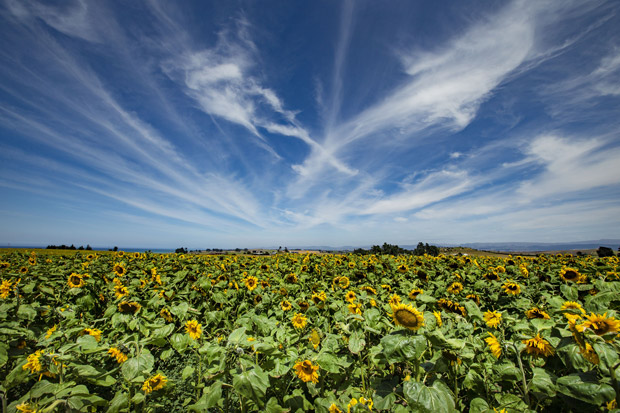
Topflite sunflowers are planted in October and harvested in late summer. The variety of flower is ‘Pole Star’, and it is used for oil and birdseed; it doesn’t produce the type of sunflower seeds eaten by humans.
Young sunflower plants move from east to west following the direction of the sun during the day (heliotropism). Mature plants settle down to face the east. The sunflower’s sun-loving tendency helps its blooms get nice and warm, which attracts pollinators.
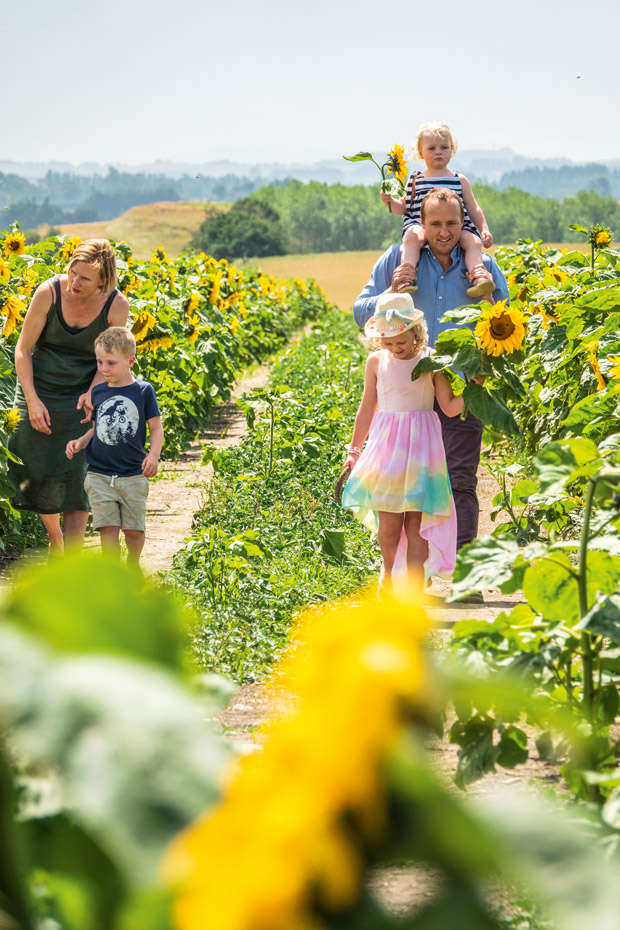
In a domestic garden, sunflowers can be planted between August and January. They tolerate poor soil but can compete with other plants. Sunflowers need at least six to eight hours of direct sunlight a day.
FEATHERED FRIENDS
To attract birds to a garden, hang a bird feeder in a place where birds will feel safe, such as a tree. Every species has its preferences; tūīs and bellbirds/korimako drink nectar and are attracted to the colour red, while tauhou (waxeye or silvereye) are fond of vegetable-suet products such as Topflite’s energy cakes and truffles.
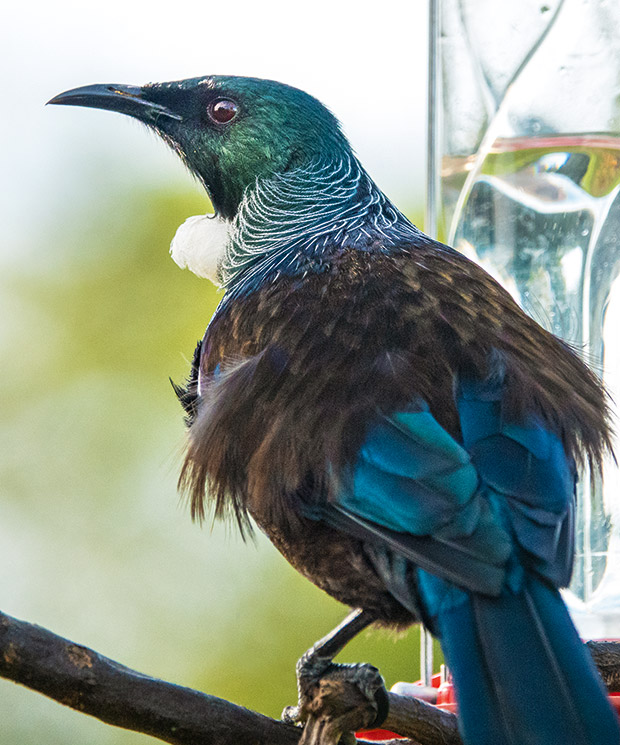
Many birds, including goldfinches, pheasants, pukekos, pigeons, thrushes, tūīs and doves enjoy a seed mix. Imported seed mixes often contain corn and other fillers and are heat-treated, reducing the nutrition value. Bread is not a good food source for most birds.
MORE HERE
Why Ōtāhuhu artist Lissy Cole is hooked on colourful crochet (and owns the word fat)
https://thisnzlife.co.nz/the-gardens-of-greenhaugh-a-trip-to-england-inspired-this-glorious-garden-in-new-plymouth/
From forbidden fruit to superfood: South Canterbury couple give blackcurrants a makeover
Love this story? Subscribe now!
 This article first appeared in NZ Life & Leisure Magazine.
This article first appeared in NZ Life & Leisure Magazine.
